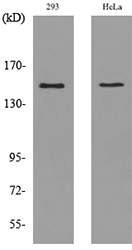CD148 Polyclonal Antibody
- Catalog No.:YT5400
- Applications:WB;IHC;IF;ELISA
- Reactivity:Human;Mouse
- Target:
- CD148
- Fields:
- >>Adherens junction;>>Chemical carcinogenesis - reactive oxygen species
- Gene Name:
- PTPRJ
- Protein Name:
- Receptor-type tyrosine-protein phosphatase eta
- Human Gene Id:
- 5795
- Human Swiss Prot No:
- Q12913
- Mouse Gene Id:
- 19271
- Mouse Swiss Prot No:
- Q64455
- Immunogen:
- The antiserum was produced against synthesized peptide derived from the Internal region of human PTPRJ. AA range:861-910
- Specificity:
- CD148 Polyclonal Antibody detects endogenous levels of CD148 protein.
- Formulation:
- Liquid in PBS containing 50% glycerol, 0.5% BSA and 0.02% sodium azide.
- Source:
- Polyclonal, Rabbit,IgG
- Dilution:
- WB 1:500 - 1:2000. IHC: 1:100-1:300. ELISA: 1:20000.. IF 1:50-200
- Purification:
- The antibody was affinity-purified from rabbit antiserum by affinity-chromatography using epitope-specific immunogen.
- Concentration:
- 1 mg/ml
- Storage Stability:
- -15°C to -25°C/1 year(Do not lower than -25°C)
- Other Name:
- PTPRJ;DEP1;Receptor-type tyrosine-protein phosphatase eta;Protein-tyrosine phosphatase eta;R-PTP-eta;Density-enhanced phosphatase 1;DEP-1;HPTP eta;Protein-tyrosine phosphatase receptor type J;R-PTP-J;CD148
- Observed Band(KD):
- 150kD
- Background:
- The protein encoded by this gene is a member of the protein tyrosine phosphatase (PTP) family. PTPs are known to be signaling molecules that regulate a variety of cellular processes, including cell growth, differentiation, mitotic cycle, and oncogenic transformation. This PTP possesses an extracellular region containing five fibronectin type III repeats, a single transmembrane region, and a single intracytoplasmic catalytic domain, and thus represents a receptor-type PTP. This protein is present in all hematopoietic lineages, and was shown to negatively regulate T cell receptor signaling possibly through interfering with the phosphorylation of Phospholipase C Gamma 1 and Linker for Activation of T Cells. This protein can also dephosphorylate the PDGF beta receptor, and may be involved in UV-induced signal transduction. Multiple transcript variants encoding different isoforms
- Function:
- catalytic activity:Protein tyrosine phosphate + H(2)O = protein tyrosine + phosphate.,disease:Defects in PTPRJ are found in cancers of colon, lung, and breast.,function:May contribute to the mechanism of contact inhibition of cell growth.,PTM:N- and O-glycosylated.,similarity:Belongs to the protein-tyrosine phosphatase family. Receptor class 3 subfamily.,similarity:Contains 1 tyrosine-protein phosphatase domain.,similarity:Contains 9 fibronectin type-III domains.,
- Subcellular Location:
- Cell membrane; Single-pass type I membrane protein. Cell projection, ruffle membrane . Cell junction. After T-cell stimulation, it is temporarily excluded from immunological synapses.
- Expression:
- Expressed in the promyelocytic cell line HL-60, the granulocyte-macrophage colony-stimulating factor-dependent leukemic cell line F-36P, and the IL3 and erythropoietin-dependent leukemic cell line F-36E. Expressed predominantly in epithelial cells and lymphocytes. Enhanced expression at high cell density.
- June 19-2018
- WESTERN IMMUNOBLOTTING PROTOCOL
- June 19-2018
- IMMUNOHISTOCHEMISTRY-PARAFFIN PROTOCOL
- June 19-2018
- IMMUNOFLUORESCENCE PROTOCOL
- September 08-2020
- FLOW-CYTOMEYRT-PROTOCOL
- May 20-2022
- Cell-Based ELISA│解您多样本WB检测之困扰
- July 13-2018
- CELL-BASED-ELISA-PROTOCOL-FOR-ACETYL-PROTEIN
- July 13-2018
- CELL-BASED-ELISA-PROTOCOL-FOR-PHOSPHO-PROTEIN
- July 13-2018
- Antibody-FAQs
- Products Images

- Western Blot analysis of HeLa, 293 cells using CD148 Polyclonal Antibody. Secondary antibody(catalog#:RS0002) was diluted at 1:20000 cells nucleus extracted by Minute TM Cytoplasmic and Nuclear Fractionation kit (SC-003,Inventbiotech,MN,USA).
.jpg)
- Immunohistochemical analysis of paraffin-embedded human-liver, antibody was diluted at 1:100

- Western blot analysis of lysate from 293, HeLa cells, using PTPRJ Antibody.



